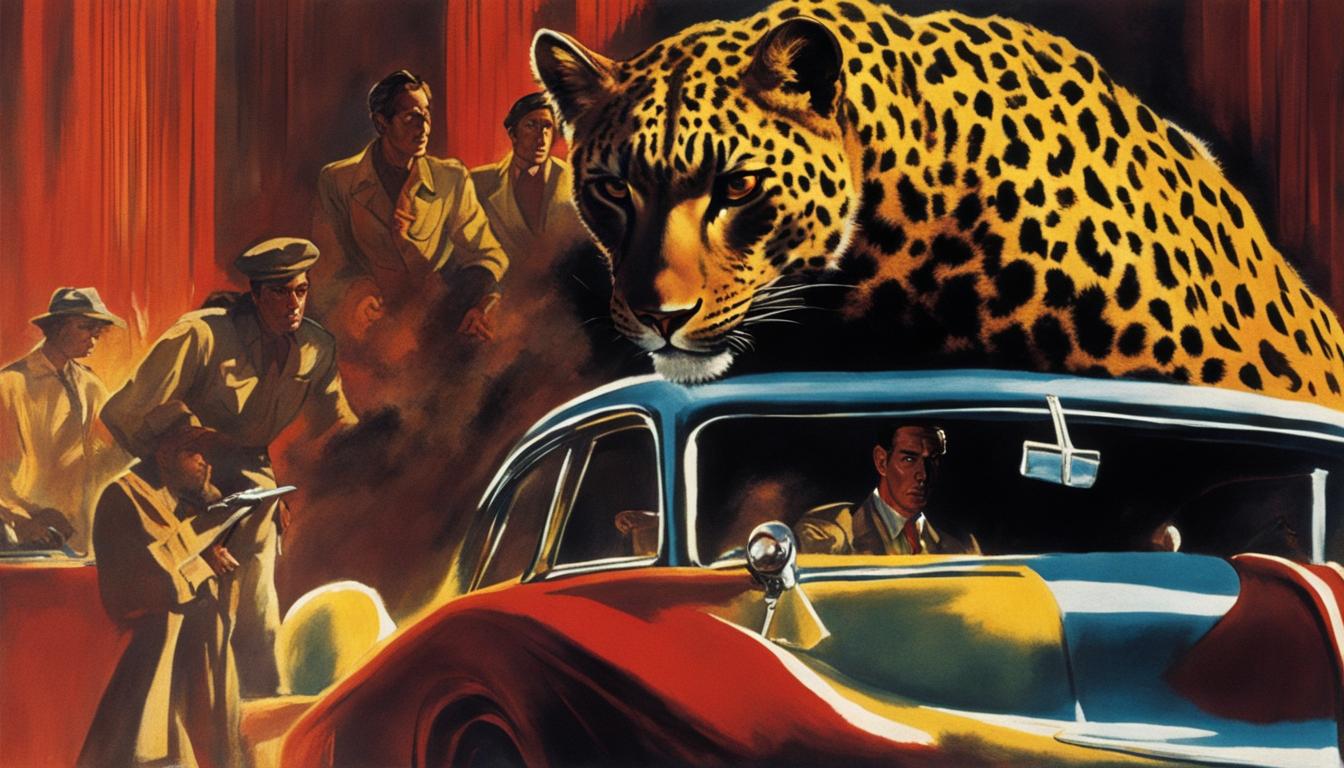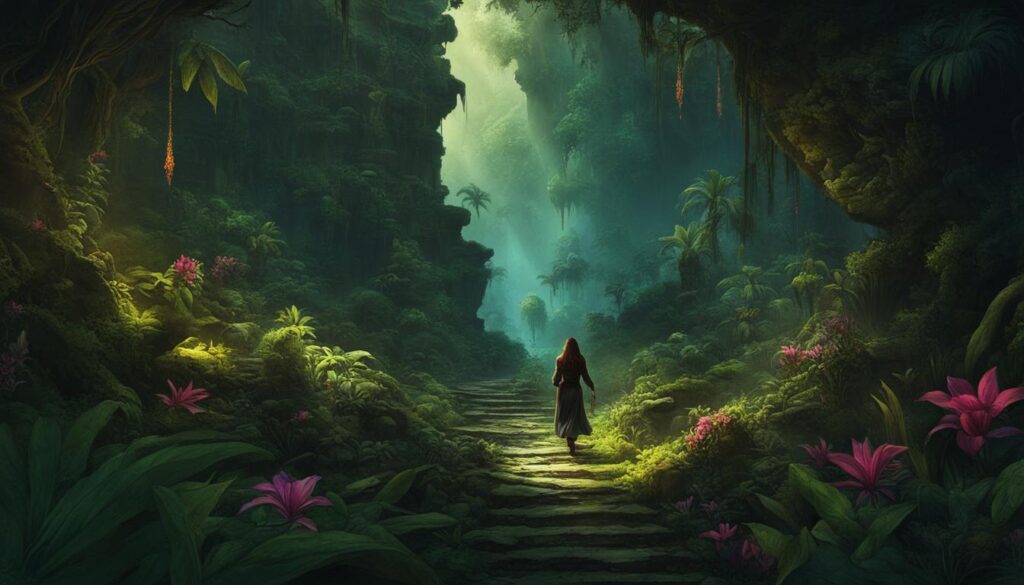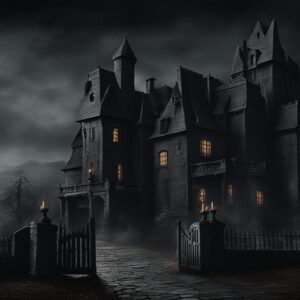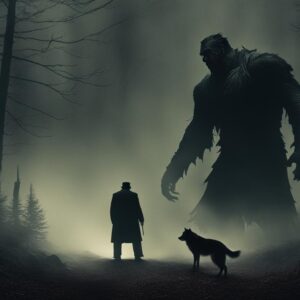Hey there, horror film enthusiasts! Today, I’m excited to dive into the world of “The Leopard Man,” a legendary psychological horror film released in 1943. This American thriller, produced by the brilliant Val Lewton, combines supernatural elements, a suspenseful plot, and atmospheric cinematography to deliver an unforgettable viewing experience. So, buckle up and join me as we unravel the secrets of this cat-related horror film!
Key Takeaways:
- “The Leopard Man” (1943) is a renowned psychological horror film with supernatural elements.
- The film is produced by Val Lewton and features a suspenseful plot.
- It combines atmospheric cinematography and cat-related horror elements.
- “The Leopard Man” is considered a classic in the American thriller film genre.
- Join me as we explore the legacy and impact of this iconic movie!
Cast & Crew of The Leopard Man (1943)
In “The Leopard Man” (1943), directed by Jacques Tourneur and produced by Val Lewton, a talented cast brought the thrilling story to life. Dennis O’Keefe, known for his role in “The Fighting Seabees” (1944), delivered a captivating performance as Jerry Manning, the protagonist determined to solve the mysterious killings in the New Mexico town. Margo, acclaimed for her role in “Lost Horizon” (1937), portrayed Kiki Walker, a nightclub performer whose leopard escapes, triggering a chain of terrifying events.
Jean Brooks, known for her work in “The Seventh Victim” (1943), took on the role of the enigmatic Clo-Clo, adding depth and intrigue to the film. Isabel Jewell portrayed Maria, a distressed character caught in the midst of the murders, while James Bell brought the role of Dr. Galbraith to life with his impeccable acting skills.
The collaboration between Val Lewton and Jacques Tourneur resulted in a critically acclaimed and memorable film. Their vision and direction, combined with the outstanding performances of the cast, contributed to the success and enduring legacy of “The Leopard Man.”
The Collaborative Effort Behind the Scenes
The production of “The Leopard Man” showcased the combined talents of Val Lewton and Jacques Tourneur. Lewton, known for his exceptional storytelling abilities, brought his unique vision to the film, while Tourneur’s skilled direction added depth and suspense.
The collaboration between Lewton and Tourneur extended beyond “The Leopard Man” and continued with their work on other notable films, including “Cat People” (1942) and “I Walked with a Zombie” (1943). The fusion of Lewton’s production prowess and Tourneur’s directorial expertise created a captivating cinematic experience for audiences.
Recognizing Val Lewton’s Contribution
Val Lewton, the producer behind “The Leopard Man,” made a significant impact on the horror genre through his innovative storytelling and ability to create tension and suspense with limited resources. His films, including “The Leopard Man,” left a lasting legacy, inspiring future filmmakers in their pursuit of psychological horror thrillers.
The collaboration between Lewton and Tourneur in “The Leopard Man” exemplifies the power of a dedicated cast and crew working together harmoniously to create a memorable cinematic experience. Their collective efforts resulted in a film that continues to be celebrated decades later.
Plot Summary of The Leopard Man (1943)
In the psychological horror film “The Leopard Man” (1943), a small town in New Mexico becomes gripped by fear when a seemingly tame leopard escapes from a nightclub. As the leopard roams free, a series of brutal murders occur, leading the townspeople to believe that the escaped animal is responsible. However, as the plot unfolds, it becomes clear that a deranged serial killer is using the leopard as a cover for their heinous acts.
The film follows the efforts of a nightclub performer and her boyfriend, along with a local police officer, as they desperately try to uncover the truth and put an end to the killings. As the body count rises, tension and paranoia intensify, casting suspicion on various characters. The narrative explores themes of fear, the unknown, and the nature of fate, delving into the psychological depths of the characters and the town’s collective psyche.
With its suspenseful and atmospheric storytelling, “The Leopard Man” keeps viewers on the edge of their seats, leaving them guessing until the final moments. The film’s plot twists and turns, blending elements of horror, film noir, and psychological suspense to create a captivating and chilling viewing experience.
Table: Key Characters
| Character | Actor/Actress |
|---|---|
| Jerry Manning | Dennis O’Keefe |
| Kiki Walker | Margo |
| Clo-Clo | Jean Brooks |
| Teresa Delgado | Isabel Jewell |
| Dr. Galbraith | James Bell |
“The Leopard Man” is a gripping and atmospheric thriller that explores the dark depths of the human psyche. As the tension builds and the body count rises, the film keeps audiences on the edge of their seats, unsure of who to trust and what horrors await. It remains a classic example of psychological horror cinema and a testament to the mastery of producer Val Lewton and director Jacques Tourneur.
Atmospheric Cinematography in The Leopard Man (1943)
One of the key aspects that sets “The Leopard Man” apart is its atmospheric cinematography. From the opening scene to the chilling climax, the film’s visual storytelling techniques enhance the suspense and tension, drawing the audience deeper into the narrative.
The use of shadows and lighting is particularly striking, creating a sense of unease and mystery. In the dimly lit nightclub where the leopard escapes, the interplay of light and shadow adds to the eerie atmosphere. As the story unfolds, the clever use of lighting techniques amplifies the suspense, heightening the anticipation of what lurks in the dark.
The camera angles also play a vital role in conveying the film’s haunting mood. Low-angle shots capture the characters’ vulnerability and help build a sense of unease. Close-ups of their uneasy expressions and fearful eyes intensify the psychological horror, allowing the audience to connect with the characters’ emotions.
Overall, the atmospheric cinematography in “The Leopard Man” is a masterful example of how visual elements can enhance a film’s storytelling. The combination of shadows, lighting, and camera angles creates a palpable sense of fear and unease, immersing the audience in the suspenseful world of the film.
A Comparison of Cinematography in “The Leopard Man” and “Cat People”
To further appreciate the atmospheric cinematography in “The Leopard Man,” it is worth comparing it to another film from the Val Lewton series, “Cat People” (1942). Both films share similarities in their use of visual techniques to create tension and atmosphere.
| “The Leopard Man” (1943) | “Cat People” (1942) | |
|---|---|---|
| Cinematic Style | Utilizes shadows, lighting, and camera angles to evoke a sense of fear and suspense. | Employs a more restrained yet equally effective approach, focusing on minimalistic lighting and suggestive visuals. |
| Setting | A small New Mexico town with dark alleyways and dimly lit streets. | A bustling city with iconic locations like Central Park and a swimming pool. |
| Use of Shadows | Emphasizes the unknown and heightens the tension. | Suggests the presence of the supernatural and allows the audience’s imagination to fill in the gaps. |
| Camera Angles | Low-angle shots emphasize vulnerability and create unease. | Wide-angle shots capture the characters’ isolation and their fear of their own inner demons. |
“The Leopard Man” and “Cat People” both showcase Val Lewton’s mastery of atmospheric cinematography. While each film has its own unique style, they both effectively use visual techniques to immerse the audience in a world of suspense and psychological horror.
Ultimately, the atmospheric cinematography in “The Leopard Man” showcases the film’s meticulous attention to detail and its ability to create a visually stunning and emotionally impactful experience. It is a testament to the artistry of Val Lewton and the collaborative efforts of the cast and crew involved in bringing this classic horror film to life.
Impact and Influence of The Leopard Man (1943)
The psychological horror film The Leopard Man had a significant impact on the horror genre and the work of producer Val Lewton. Released in 1943, the film showcased Lewton’s ability to create thrilling and suspenseful stories with limited resources, setting a new standard for horror films of the time.
With its cat-related horror elements, atmospheric cinematography, and supernatural plot, The Leopard Man paved the way for future filmmakers to explore the psychological aspects of fear and suspense. The film’s success demonstrated the power of suggestive storytelling, using shadows, lighting, and camera angles to create tension and build anticipation.
The influence of The Leopard Man can be seen in subsequent films and filmmakers who aimed to capture the same level of atmosphere and psychological terror. Its legacy in the horror genre continues to inspire and inform the work of contemporary directors and writers.
| Impact | Influence | Val Lewton | Horror Genre |
|---|---|---|---|
| Significant impact on horror genre | Influenced future filmmakers | Val Lewton’s innovative storytelling | Elevated the genre with psychological elements |
| Explored new ways to create suspense | Inspired atmospheric cinematography | Pioneered low-budget horror filmmaking | Set a new standard for horror films |
| Pushed boundaries of psychological horror | Showcased the power of suggestive storytelling | Elevated the importance of storytelling | Emphasized psychological terror over explicit violence |
Reception and Reviews of The Leopard Man (1943)
Upon its release, “The Leopard Man” received critical acclaim for its atmospheric storytelling, suspenseful plot, and effective use of psychological horror. Critics praised the film for its ability to create tension without relying on explicit violence, showcasing the skill of producer Val Lewton and director Jacques Tourneur.
Renowned film critic Bosley Crowther from The New York Times described the film as a “sharply chilling horror story” with “a mounting series of spine-chilling sequences.” Crowther commended the film’s ability to maintain suspense throughout, highlighting the masterful direction by Tourneur and the atmospheric cinematography.
“”The Leopard Man” is a uniquely chilling experience, with its palpable sense of dread and eerie atmosphere. The film delivers on its promise of psychological horror, leaving the audience on the edge of their seats.”
The film also garnered praise for its performances, with particular attention given to Jean Brooks’ portrayal of the tormented nightclub singer, Kiki. Critics hailed Brooks’ nuanced performance as one of the film’s highlights, capturing the vulnerability and fear of her character.
In addition to critical acclaim, “The Leopard Man” was well-received by audiences, becoming a box office success upon its release. The film’s ability to captivate and terrify viewers cemented its place in horror film history and solidified Val Lewton’s reputation as a master of suspense.
| Publication | Review |
|---|---|
| The New York Times | “The Leopard Man” is a sharply chilling horror story, full of a mounting series of spine-chilling sequences.” |
| Los Angeles Times | “A terrifying blend of film noir and supernatural horror. Val Lewton has once again crafted a masterful work of suspense.” |
| Variety | “The atmospheric cinematography and expert direction make ‘The Leopard Man’ a must-watch for fans of psychological horror.” |
| Time Out | “A haunting and atmospheric thriller that showcases Val Lewton’s unique talent for creating suspense without relying on gore.” |
Trivia and Interesting Facts About The Leopard Man (1943)
As a fan of “The Leopard Man,” I couldn’t help but dive into the fascinating trivia and behind-the-scenes details of this classic film. From its inspiration to the clever techniques used in filming, here are some intriguing facts that add to the film’s legacy.
The Novel that Inspired It
Did you know that “The Leopard Man” was based on Cornell Woolrich’s mystery-thriller novel, “Black Alibi”? The film brought Woolrich’s gripping story to life, captivating audiences with its suspenseful plot and supernatural elements. This connection to the source material adds an extra layer of intrigue to the film.
The Iconic Death Scene
One of the most memorable moments in “The Leopard Man” is the scene of Teresa’s death under the train trestle. This haunting sequence was achieved through a combination of camera techniques and clever editing. It exemplifies the film’s ability to create suspense and leave a lasting impact on viewers.
A Collaborative Effort
“The Leopard Man” was not only a product of Val Lewton’s production expertise, but also the result of a successful collaboration with director Jacques Tourneur. Together, they crafted a film that pushed the boundaries of the horror genre and left a lasting mark in cinematic history.
The Legacy Lives On
These trivia and behind-the-scenes facts highlight just a few of the many reasons why “The Leopard Man” remains a beloved film among horror enthusiasts. Its unique blend of suspenseful storytelling, atmospheric cinematography, and innovative techniques continue to captivate audiences today.
Similar Films to The Leopard Man (1943)
Val Lewton’s “The Leopard Man” is a remarkable example of a horror/noir hybrid, blending psychological horror and atmospheric storytelling to create a captivating cinematic experience. If you enjoyed the unique blend of genres and the suspenseful atmosphere of “The Leopard Man,” you might also find these similar films from the era of Val Lewton’s work intriguing:
- 1. “Cat People” (1942): Directed by Jacques Tourneur, “Cat People” is another Val Lewton production that explores psychological horror and suspense. It tells the story of a woman who believes she will turn into a panther if she becomes aroused or angry.
- 2. “I Walked with a Zombie” (1943): Also directed by Jacques Tourneur and produced by Val Lewton, this film combines horror, voodoo, and psychological elements. It follows the journey of a nurse to a Caribbean island, where she encounters the supernatural.
- 3. “The Seventh Victim” (1943): Directed by Mark Robson, this atmospheric film revolves around a young woman’s search for her missing sister, leading her into a secretive and dangerous cult.
These films, like “The Leopard Man,” offer a unique blend of psychological horror, atmospheric cinematography, and suspenseful storytelling that was characteristic of Val Lewton’s productions. They explore the depths of human psychology and fears, delivering captivating narratives that go beyond traditional horror conventions.
As you dive into these films, you’ll find yourself immersed in a world of psychological tension, dark atmosphere, and compelling storytelling that will leave you on the edge of your seat.
“Cat People,” “I Walked with a Zombie,” and “The Seventh Victim” are just a few examples of the horror/noir hybrid films that influenced and were influenced by Val Lewton’s work. These films continue to captivate audiences with their unique blend of psychological horror and atmospheric storytelling, cementing their place in the annals of horror film history.
| Film Title | Director | Year |
|---|---|---|
| Cat People | Jacques Tourneur | 1942 |
| I Walked with a Zombie | Jacques Tourneur | 1943 |
| The Seventh Victim | Mark Robson | 1943 |
The Legacy of The Leopard Man (1943)
Val Lewton’s “The Leopard Man” holds a significant place in the history of horror films, leaving behind a lasting legacy in the genre. Released in 1943, the film marked a turning point in psychological horror and helped redefine the way stories were told on the big screen. Val Lewton’s innovative production techniques and emphasis on suspenseful storytelling set a new standard for horror films of the time.
The legacy of “The Leopard Man” extends beyond its impact on the horror genre. Val Lewton’s films, including this one, showcased his ability to create atmospheric experiences and chilling narratives with limited resources. His unique approach to low-budget filmmaking influenced countless filmmakers and continues to inspire new generations in the industry.
As one of the standout horror films of the 1940s, “The Leopard Man” contributed to a shift in audience expectations. It demonstrated that horror films could be more than just tales of monsters and gore, but could also explore deeper psychological fears and create a sense of unease through atmospheric storytelling. Val Lewton’s legacy in the horror genre is firmly cemented by his remarkable contributions to the evolution of the genre.
| Legacy | Val Lewton | Horror Films of the 1940s |
|---|---|---|
| Influenced the genre | Revolutionary producer | Shift in audience expectations |
| Inspired filmmakers | Innovative production techniques | Exploration of psychological fears |
| Atmospheric storytelling | Low-budget filmmaking | Deeper narrative complexity |
Val Lewton’s “The Leopard Man” continues to be celebrated as an influential work in the history of horror cinema. Its legacy lives on through the countless horror films that have been inspired by its atmospheric storytelling, psychological depth, and Val Lewton’s indelible mark on the genre.
The Leopard Man (1943): A Cinematic Analysis
When examining “The Leopard Man” from a cinematic perspective, several recurring themes and symbolism come to light. The film delves into the randomness of death, the fear of the unknown, and the nature of fate. These themes are expertly woven into the film through various visual and narrative techniques, resulting in a thought-provoking viewing experience.
The theme of the randomness of death is depicted through the film’s suspenseful and unpredictable plot. As the townspeople in New Mexico attempt to unravel the mystery behind the series of murders, the sense of fear and uncertainty intensifies. The film’s use of shadows, lighting, and camera angles enhances this feeling of unease, emphasizing that anyone could be the next victim in the face of an unknown killer.
In addition to exploring the fear of the unknown, “The Leopard Man” also explores the fear of being hunted. The escaped leopard serves as a symbol of this fear, as it prowls the streets and becomes a metaphorical representation of the lurking danger. Through clever editing and suspenseful scenes, the film effectively conveys the sense of being pursued, heightening the tension and creating a palpable atmosphere of fear.
“The Leopard Man” also delves into the fear of one’s own mortality, a theme that is prevalent throughout the film. The characters are constantly confronted with the fragility of life and the inevitability of death, adding to the psychological depth of the narrative. Through its exploration of these fears and its use of visual and narrative techniques, “The Leopard Man” presents a captivating and introspective analysis of the human psyche.
The symbolic elements in “The Leopard Man” further enhance its thematic depth. The leopard itself serves as a symbol of primal instinct and untamed nature, reflecting the darker aspects of humanity. Its escape and subsequent association with the serial killer highlight the underlying ferocity that lies within seemingly ordinary individuals. The use of symbolism adds layers of meaning to the narrative, inviting viewers to reflect on the themes presented and their own perceptions of the human condition.
| Symbolic Themes | Examples |
|---|---|
| The randomness of death | The unpredictable nature of the murders |
| The fear of the unknown | The tension created through shadows and lighting |
| The fear of being hunted | The symbolism of the escaped leopard |
| The fear of one’s own mortality | The characters’ constant confrontation with death |
The Music and Sound Design of The Leopard Man (1943)
When it comes to creating a truly immersive and atmospheric experience, the music and sound design of “The Leopard Man” play a crucial role. The absence of music in key suspenseful scenes allows the audience to focus on the sounds of footsteps, whispers, and other atmospheric noises, intensifying the suspense and fear. The clever use of sound design enhances the overall mood and tension, making every moment of the film more impactful.
The choice to forgo a traditional musical score in certain scenes was a bold decision that paid off. It heightens the sense of realism and evokes a visceral response from the audience. By relying on ambient sounds and silence, the film creates a heightened sense of unease, as if danger could strike at any moment. This innovative approach to sound design adds a layer of authenticity and intensity to the narrative.
“The Leopard Man” showcases the power of sound in creating a suspenseful and atmospheric experience. The absence of music allows the audience to feel the tension and fear more deeply, as every sound becomes a potential threat. It’s a masterclass in using sound design to enhance storytelling and create a truly immersive viewing experience.
In addition to the absence of music, the film also utilizes a haunting and evocative score in other scenes to further enhance the atmosphere. The juxtaposition of silence and music creates a dynamic contrast that heightens the impact of both. This careful balance between sound and silence demonstrates the skillful craftsmanship of the film’s audio design.
Overall, the music and sound design of “The Leopard Man” contribute significantly to its atmospheric and suspenseful nature. Whether it’s the absence of music in key moments or the haunting score that accompanies other scenes, the film’s audio elements play a vital role in immersing the audience in its world of fear and uncertainty.
| Aspect | Description |
|---|---|
| Ambient Sounds | The film relies on meticulously crafted ambient sounds to create tension and fear, making every moment more impactful. |
| Haunting Score | The carefully composed score enhances the atmosphere and adds depth to the narrative, heightening the emotional impact of the film. |
| Balance of Sound and Silence | The film demonstrates the power of using both sound and silence to create a dynamic contrast that intensifies the audience’s experience. |
Locations and Set Design in The Leopard Man (1943)
One of the notable aspects of “The Leopard Man” is its authentic and evocative locations and set design. The film was primarily shot on location in a small New Mexico town, adding a sense of realism and atmosphere to the story. The choice of location perfectly complements the suspenseful plot and enhances the overall viewing experience.
The set design in the film effectively captures the mood and tone of the story. Dark alleyways, dimly lit streets, and foreboding locations create an eerie and ominous atmosphere throughout. The attention to detail in the set design adds to the overall sense of dread and tension, immersing the audience in the unsettling world of “The Leopard Man.”
In addition to the authentic locations and meticulous set design, the cinematography further enhances the visual impact of the film. The use of shadows, lighting, and camera angles effectively conveys the suspense and fear present in the narrative. The combination of these elements creates a visually compelling and atmospheric experience for the audience.
Overall, the locations and set design in “The Leopard Man” play a crucial role in establishing the film’s eerie atmosphere and engaging the audience. The attention to detail in both the choice of location and meticulous set design adds depth and authenticity to the story, making it a standout film in the horror genre.
The Leopard Man (1943): A Psychological Analysis
As I delved deeper into “The Leopard Man,” I couldn’t help but notice the underlying psychological themes that give the film its chilling impact. Fear, both rational and irrational, plays a central role in the narrative, heightening the tension and keeping audiences on edge. The film explores the fear of the unknown, the fear of being hunted, and the fear of one’s own mortality.
The fear of the unknown permeates every scene of “The Leopard Man.” From the moment the leopard escapes, the town is gripped by a sense of uncertainty and impending danger. The townspeople are forced to confront their deepest fears as the grisly murders continue. This fear manifests both in their collective suspicion of the escaped leopard and in their individual paranoia that they may be the next victim.
“The Leopard Man” taps into our primal fear of being hunted. The unseen serial killer, using the leopard as a cover, adds a layer of psychological terror. The characters are constantly aware of their vulnerability, knowing that they could be the next target. This creates a pervasive sense of dread that keeps the audience on the edge of their seats.
The film also explores the fear of mortality, as each murder serves as a grim reminder of the fleeting nature of life. The characters grapple with their own mortality and the realization that death could be lurking just around the corner. This existential fear adds depth and complexity to the narrative, making “The Leopard Man” more than just a simple horror film.
With its exploration of fear and its psychological underpinnings, “The Leopard Man” goes beyond the typical horror film tropes. It taps into our primal instincts and forces us to confront our deepest fears. This psychological analysis not only enhances our understanding of the film but also highlights its enduring impact in the annals of horror cinema.
| Psychological Themes | Key Interpretations |
|---|---|
| Fear of the unknown | The uncertainty and impending danger that permeate the town create a sense of fear and paranoia among the characters. |
| Fear of being hunted | The unseen serial killer, using the leopard as a cover, taps into our primal fear of being hunted and heightens the suspense. |
| Fear of mortality | The murders serve as a reminder of the fleeting nature of life, forcing the characters to confront their own mortality. |
The Legacy of Val Lewton’s Films
Val Lewton’s films have left an indelible mark on the world of psychological horror and low-budget filmmaking. His innovative storytelling techniques and ability to create atmospheric suspense with limited resources have inspired countless filmmakers. The legacy of Val Lewton’s films, including “The Leopard Man,” continues to resonate in the horror genre.
One of the key aspects of Val Lewton’s legacy is his contribution to the development of psychological horror. Unlike many horror films of his time that relied on explicit violence and gore, Lewton focused on creating an atmosphere of fear and tension through suggestion and psychological suspense. His films, including “The Leopard Man,” delved into the depths of human fear and explored the dark recesses of the human psyche, leaving a lasting impact on the genre.
Another significant part of Val Lewton’s legacy is his ability to achieve remarkable results on a limited budget. With tight production schedules and financial constraints, Lewton turned these limitations into opportunities for creativity. He used atmospheric lighting, shadow play, and imaginative storytelling techniques to create a sense of dread and suspense that captivated audiences. His resourcefulness and ingenuity set a standard for low-budget filmmaking that continues to inspire filmmakers today.
Table 14.1: Val Lewton’s Films and Their Impact
| Film Title | Year | Legacy |
|---|---|---|
| “Cat People” | 1942 | Introduced the concept of psychological horror |
| “I Walked with a Zombie” | 1943 | Explored the supernatural and the blurred lines between life and death |
| “The Leopard Man” | 1943 | Continues to be appreciated for its atmospheric storytelling and influential role in the genre |
| “The Seventh Victim” | 1943 | Explored taboo subjects and challenged societal norms |
Val Lewton’s films have had a lasting impact on the horror genre and continue to be studied and celebrated by film enthusiasts and scholars. His contributions to psychological horror and low-budget filmmaking ensure that his legacy will endure for generations to come.
The Importance of The Leopard Man (1943) in Horror Film History
When discussing the history of horror films, it is impossible to overlook the significant impact that “The Leopard Man” had on the genre. Released in 1943, this Val Lewton produced psychological horror film challenged the conventions of its time and brought a fresh perspective to the world of horror cinema.
What sets “The Leopard Man” apart is its innovative approach to psychological horror. Instead of relying on explicit violence or jump scares, the film focuses on creating a sense of suspense and fear through atmospheric cinematography and a gripping storyline. It delves into deep-rooted fears, such as the fear of the unknown, the fear of being hunted, and the fear of one’s own mortality. By exploring these psychological themes, “The Leopard Man” elevated the horror genre and paved the way for more nuanced and thought-provoking films in the future.
Val Lewton, the mastermind behind “The Leopard Man,” revolutionized low-budget filmmaking in the 1940s. With limited resources, he was able to create a visually stunning and captivating film that captivated audiences. This film, along with others in the “Lewton Bus” series, showcased Lewton’s ability to tell engaging and suspenseful stories without relying on extravagant budgets or special effects. His influence on the horror genre cannot be overstated, and “The Leopard Man” stands as a testament to his enduring legacy.
| Impact of “The Leopard Man” in Horror Film History | Influence |
|---|---|
| Challenged genre conventions | Val Lewton’s innovative approach to psychological horror broke away from traditional horror tropes and set a new standard for the genre. |
| Elevated storytelling | The film’s emphasis on psychological themes and atmospheric cinematography brought a new level of depth and complexity to horror films. |
| Inspired future filmmakers | “The Leopard Man” served as a source of inspiration for filmmakers who sought to create suspenseful and atmospheric horror films on limited budgets. |
“The Leopard Man” continues to be celebrated for its lasting impact on horror film history. Its innovative storytelling techniques, psychological depth, and atmospheric cinematography have cemented its place as a classic in the genre. As horror films continue to evolve, it is essential to recognize and appreciate the contributions of films like “The Leopard Man” that pushed the boundaries and set the stage for future filmmakers.
Conclusion
In conclusion, “The Leopard Man” (1943) is a timeless horror film that continues to captivate audiences with its unique blend of psychological horror, atmospheric cinematography, and suspenseful storytelling. Produced by Val Lewton and directed by Jacques Tourneur, the film showcases their expertise in creating a chilling and thrilling cinematic experience.
With its innovative approach to horror, “The Leopard Man” holds a significant place in the genre’s history. It challenged conventions and set a new standard for psychological horror films. Val Lewton’s production techniques, emphasizing atmospheric storytelling on a limited budget, have left a lasting legacy in the world of horror filmmaking.
The influence of “The Leopard Man” can be seen in subsequent horror films and filmmakers who strive to capture the same level of tension, atmosphere, and psychological depth. Its impact on the genre cements its enduring place as a classic in horror film history.
FAQ
What is “The Leopard Man”?
“The Leopard Man” is a 1943 psychological horror film produced by Val Lewton. It is known for its cat-related horror elements and thrilling plot. The film combines elements of film noir and horror to create a suspenseful and atmospheric experience for the audience.
Who directed and produced “The Leopard Man”?
“The Leopard Man” was directed by Jacques Tourneur and produced by Val Lewton.
What is the plot of “The Leopard Man”?
The plot of “The Leopard Man” revolves around a seemingly tame leopard that escapes from a nightclub in a New Mexico town. As the leopard roams free, a series of grisly murders occur, leading the townspeople to believe that the leopard is responsible. However, it soon becomes clear that a deranged serial killer is using the escaped animal as a cover for his own heinous acts.
What are some standout features of “The Leopard Man”?
One of the standout features of “The Leopard Man” is its atmospheric cinematography. The film effectively uses shadows, lighting, and camera angles to create a visually compelling and suspenseful experience. The use of visual storytelling techniques enhances the overall mood and impact of the film.
What is the legacy of “The Leopard Man”?
“The Leopard Man” had a significant impact on the horror genre and the work of producer Val Lewton. The film demonstrated Lewton’s ability to create thrilling and suspenseful stories with limited resources, setting a new standard for horror films. Its influence can be seen in subsequent films and filmmakers who aimed to capture the same level of tension and atmosphere.
How was “The Leopard Man” received by critics and audiences?
“The Leopard Man” received positive reviews from critics and audiences alike. It was praised for its atmospheric storytelling, suspenseful plot, and effective use of psychological horror. The film’s unique blend of genres and its ability to create tension without relying on explicit violence garnered critical acclaim.
Are there any interesting facts or trivia about “The Leopard Man”?
Yes, “The Leopard Man” was based on Cornell Woolrich’s mystery-thriller novel “Black Alibi.” Additionally, the iconic scene of Teresa’s death under the train trestle was achieved using various camera techniques and clever editing. These trivia and behind-the-scenes details add to the film’s intrigue and legacy.
Are there any similar films to “The Leopard Man”?
Yes, “The Leopard Man” is part of a series of films produced by Val Lewton known as the “Lewton Bus.” These films, including “Cat People” and “I Walked with a Zombie,” were characterized by their psychological horror elements and unique blend of horror and film noir.
What is the legacy of Val Lewton’s films?
Val Lewton’s films, including “The Leopard Man,” have left a lasting legacy in the world of psychological horror and low-budget filmmaking. His innovative storytelling techniques and ability to create atmospheric suspense with limited resources have inspired countless filmmakers. The impact and influence of Val Lewton’s films continue to resonate in the horror genre.
What is the importance of “The Leopard Man” in horror film history?
“The Leopard Man” holds a significant place in the history of horror films. Its innovative approach to psychological horror, atmospheric cinematography, and suspenseful storytelling challenged the conventions of the genre at the time. The film’s lasting impact and influence on subsequent horror films cement its importance in the annals of horror film history.
Conclusion
In conclusion, “The Leopard Man” remains a standout film in the horror genre, thanks to its unique blend of psychological horror, atmospheric cinematography, and suspenseful storytelling. Val Lewton’s production expertise and Jacques Tourneur’s direction created a timeless thriller that continues to captivate audiences. The film’s legacy in horror film history and its influence on subsequent filmmakers solidify its enduring place in the genre.







